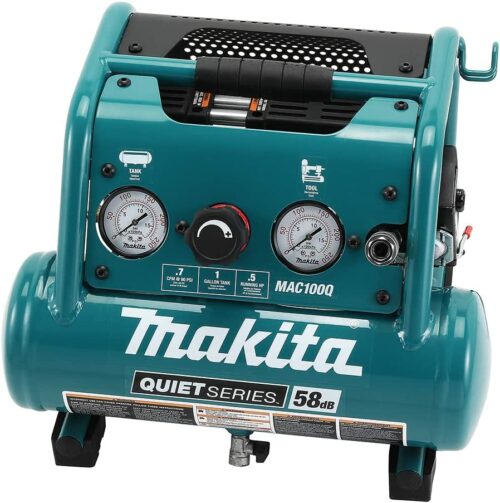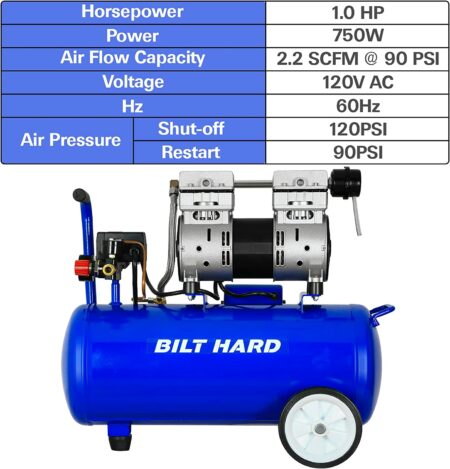What are the many compressor types, and which one should I purchase?
You are in the proper place if this is a question on your mind.
The air compressor is one of the most useful and, in my opinion, most important instruments for a handyman. Any handyman who doesn’t have at least one of these tools in his garage or workshop is doing himself a grave disservice because they can be utilized for such a wide variety of tasks. They may assist you with anything from painting projects to letting you fill up your tires, among many other things.
I’m here to help if you’re stuck because you don’t know the first thing about air compressors but you also know you want one. I’ll try my best to offer you a crash education in air compressors in this essay. I’ll try my best to describe how each variety of them functions because there are so many distinct kinds.
Table of Contents
Types of air compressors according to the compression method

Hold onto your hats because this section of the post will become highly technical and involve a lot of discussion of terms that are extremely technical. I’ll be examining the various operating principles for air compressors in this part.
Positive displacement compressors and dynamic compressors are the two primary types of air compressors, depending on the compression technique. Positive displacement air compressors include the widely used reciprocating and rotary screw models, whereas dynamic air compressors include centrifugal models.
What does that actually mean? Well, different types of air compressors compress and transmit air using various techniques. Different working theories each have their own merits and drawbacks. In this section of the post, I’ll discuss some of the more popular air compressor kinds that you may find if you went air compressor shopping.
In general, there are two fairly broad groups that you can place the working theories of air compressors into.
compressors for positive displacement air and
air compressors that move.
As seen in the graphic below, there are various types of air compressors falling within these two categories. The creation of compressed air is the same result for each. But the methods used to produce that can vary greatly.
Here is a list of the several air compressor types that are most frequently utilized.
Types of Positive Displacement
- Compressors of the Rotary Type
- compressor with a rotary screw
- kind of rolling piston
- the vane compressor
- compressed air scroll
Type of liquid piston
- rotational compressors
- pneumatic compressor
- Single-acting
- Double-acting
- Adaptive Types
- compressor with axial flow
- rotating-blade compressor
Type of air bubble
Diagonal or mixed-flow compressor

Comparison of Dynamic and Positive Displacement Compressors
Positive displacement compressors typically operate by drawing as much air into a small space as they can. The space is then gradually shrunk, which results in a sharp increase in air pressure. This is how compressed air is created.
Of the two, dynamic air compressors are less typical. They function by driving air through a number of revolving components. This causes the air to speed up, giving it kinetic energy, which causes the air pressure to increase. Additionally, a lot of dynamic air compressors actively absorb moisture from the air, which again aids in boosting power.
Positive displacement compressors are first.
Let’s start by discussing the various positive displacement compressor types that are on the market and that you can encounter while purchasing.
Compressors using rotary screws
Two pairs of screws that mesh with one another are used in rotary screw compressors. The air is forced into a progressively smaller space by rotating these screws. This has the effect of significantly increasing the amount of air pressure that the compressor emits, as I mentioned previously.
Because they are quite dependable and, more importantly, very consistent when it comes to power output, rotary screw compressors are fairly prevalent, especially in professional shops. A rotary screw compressor will always have the strength required to complete the task, so you can depend on it.
Compressors that reciprocate
These compressors function quite similarly to rotary screw types. Reciprocal compressors employ a sequence of pistons to force air out of the compressor, which is the main difference from screw-based compressors. Because they are affordable and simple to use, these types of compressors are also highly popular.
However, they might be a little less potent depending on the number of pistons in the air compressor. For simpler tasks that require less power, for instance, air compressors with a single piston are preferable. Clearly, for tasks requiring a significant increase in power output, air compressors with more pistons are preferable.
Secondly, dynamic air compressors
There aren’t as many dynamic air compressors as positive displacement counterparts. Due to the fact that there are only two types of dynamic air compressors that you are likely to encounter, I will only discuss them.
Compressors for centrifugal air
As implied by its name, this kind of compressor operates by utilizing the centrifugal force of a rotating object.
A centrifugal air compressor’s mechanism of operation
A rotor (also known as an impeller) that is put together inside of an involute casing makes up the essential components of a centrifugal compressor. Vanes, another name for the blades that make up the impeller. Air is forced in a radial direction by the rotating vanes on the impeller as it rotates by entering the casing through the eye (nozzle) of the impeller.
The air is forced toward the outer edges of the volute case by centrifugal force. The air traveled through a channel called a diffuser before entering the volute, which increased pressure while slowing the air’s velocity. The diverging vanes of a centrifugal compressor that have more space between them toward the end itself can serve as a diffuser.
As a result, the volute receives compressed air that is sent via the exit. There is a pressure drop inside the case as the compressed air leaves the volute. This will allow the inlet nozzle to draw in more air from the atmosphere.
centrifugal compressors are used in
These air compressors operate in a genuinely brilliant and amazing manner. In essence, they draw air in and pass it through a number of processes. Each stage involves cooling and compressing the air while also removing moisture. These things all work together to supercharge the air and inject it with significant energy.
This added power significantly contributes to this type of air compressor being the preferred choice for individuals who require a lot of power. Many will advise you to use a centrifugal air compressor since you know it will always have the strength to complete the task at hand if the work calls for more than 250 horsepower rather than taking a chance.
A high-end centrifugal air compressor can easily reach upwards of 6,000 horsepower, albeit the highest limit of the compressor’s power output will vary from machine to machine. Obviously, this makes it a favorite among experts or other people who might require all that power.
The Axial Compressor
Because they are so strong, axial compressors are perhaps the most uncommon kind of compressor because they are only used in things like engines and power generators. They generate force using the same underlying theory as centrifugal air compressors. Various processes that compress the air and add kinetic energy are continuously applied to it.
Despite the fact that I’ve included it on this list, I must admit that it’s doubtful that the majority of people who are reading this will ever need to use an axial air compressor. But it never hurts to have a little more knowledge about these instruments.
Depending On The Power Source, Air Compressors

Examining the many ways that air compressors are powered is another technique to look for them. Since there are only two ways to operate an air compressor—with gas or electricity—this might be a simple approach to quickly exclude a wide variety of air compressors from your search.
It’s very self-explanatory how each compressor operates, so I won’t go into detail about it. I would rather concentrate on the benefits and drawbacks of each sort of power source.
Powerful air compressors
The benefits of switching to electric generally revolve around not having to deal with gas. You end up saving a lot of money because you don’t have to worry about buying petrol, especially if you use your air compressor frequently. It also implies that operating the air compressor won’t expose you to any unpleasant gas emissions.
Additionally, electric air compressors are typically much lighter and less expensive in general. Why? They can afford to cut expenses a little bit and be a lot lighter because they don’t need to accommodate components to hold and process the gas.
Going electric has two main drawbacks. First off, it should go without saying that electric air compressors should always be placed adjacent to a plug. Of course, you could use an extension cable, but the majority of specialists will caution you against doing so because it could cause circuit damage when used to power extremely strong tools.
Second, it is undeniable that electric air compressors are less potent. They are significantly less powerful than their gas-powered equivalents, although they are not necessarily “under-powered.” You should take this into account when shopping.
Compressor powered by gas
The pros and cons of a gas air compressor are essentially the reverses. On average, gas air compressors are unquestionably far more powerful than their electric counterparts. There is a very good probability that you will need to employ a gas-powered compressor if you require raw power for a certain task.
Gas compressors have certain noticeable drawbacks that you should be aware of, as you might have already guessed. They are more expensive, do require you to keep a supply of gas on hand (and put up with the foul smells), and are a little bit heavier. Therefore, the wise handyman will need to decide whether these sacrifices are worthwhile for a little bit more power.
According to Lubrication
When viewed from the outside, air compressors may not appear to have many shockingly delicate internal parts, but they actually have. As you may expect, these components eventually begin to wear out because they are continually in contact with one another. Therefore, lubrication of some kind is required for every air compressor in order to prevent component wear. One technique for separating air compressors is through the lubricating process.
lubricated air compressors using oil
It shouldn’t come as much of a surprise that one of the most popular ways to lubricate air compressors is using oil as it is by far one of the most common ways to lubricate just about anything. Oil-lubricated air compressors are often more expensive and heavier than their counterparts, but many experts swear by them since they last so much longer.
Air Compressors Without Oil
There are substitutes available that don’t include oil. They typically weigh a great deal less and cost a little less as well. Air compressors that don’t utilize oil for lubrication typically choose a specialized lubricant instead. This lubricant, which performs the same function that oil typically does, has already been applied to the components inside the air compressor.
There are several drawbacks to oil-free models that must be taken into consideration, despite the fact that the difference in cost and weight may seem like a fantastic trade-off. First off, many experts claim that the protective coating quickly deteriorates, which causes the air compressor to fail because the internal parts inevitably start to deteriorate.
Second, because there is no lubricating oil present, these air compressors are typically much noisier. This is brought on by the parts rubbing against one another without any lubrication. If you work in a residential neighborhood, your neighbors might not appreciate the noise, even though you might not.
Using the tank design
The general design of the tank on an air compressor can also be used to generally classify them. Tank shapes vary across different air compressors. The advantages and disadvantages of the various types of tanks are not particularly significant, but they are nonetheless worth mentioning.
burger tanks
Many compressor tanks are called for the culinary item they most closely resemble. The pancake tanks are a prime example. Pancake tanks are extremely light, making them simple to store. They are called from the fluffy culinary item of the same name.
This kind of compressor will function just well if you need one for a nail gun. It must be mentioned, nevertheless, that these tanks are somewhat undersized in terms of capacity.
Hotdog troughs
Hotdog tanks are formed like hotdogs, contrary to pancake tanks which are light and compact. They are therefore long and round in shape. They also occupy a lot more room than pancake-shaped tanks, but their increased capacity makes up for this. As a result, you need to replenish the tank much less frequently.
Impact wrenches and pneumatic power tools that require a brief burst of compressed air are advised to use this kind of air compressor.
Vertical or Horizontal
The general orientation of the tank is another element to take into account. You can select an air compressor model with a horizontal tank or a vertical tank when making a purchase. Don’t concentrate too much on the decision because it’s not a big one.
Conclusion
If you came to this post with no prior knowledge of air compressors, you likely know more than enough today to proceed with a wise purchase. If you already had a solid understanding of these techniques, maybe this served as a helpful review for you.


